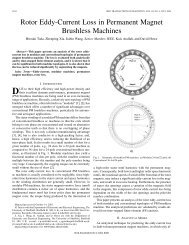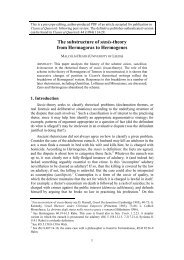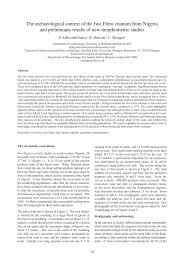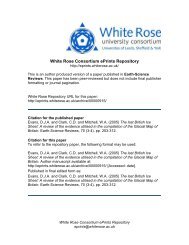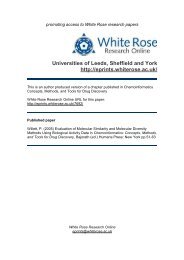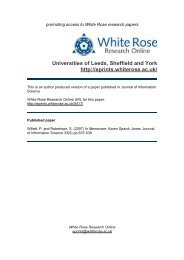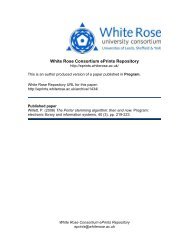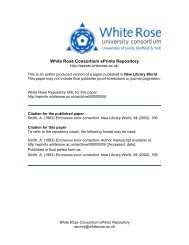The last British Ice Sheet: A review of the evidence utilised in the ...
The last British Ice Sheet: A review of the evidence utilised in the ...
The last British Ice Sheet: A review of the evidence utilised in the ...
Create successful ePaper yourself
Turn your PDF publications into a flip-book with our unique Google optimized e-Paper software.
water on its surface. Once <strong>the</strong> Irish Sea ice had retreated it allowed <strong>the</strong> Welsh ice to advance over <strong>the</strong><br />
sediments.<br />
On <strong>the</strong> west Wales coast, substantial mora<strong>in</strong>es lie <strong>of</strong>fshore <strong>in</strong> Cardigan Bay. Foster (1970b) and Garrard<br />
and Dobson (1974) identified <strong>the</strong> Sarn Badrig, Sarn-y- Bwlch and Sarn Cynfel<strong>in</strong> <strong>of</strong>fshore mora<strong>in</strong>es<br />
document<strong>in</strong>g Welsh glacier flow <strong>in</strong>to Cardigan Bay as a series <strong>of</strong> lobes. Garrard and Dobson (1974) fur<strong>the</strong>r<br />
identified <strong>the</strong> limit <strong>of</strong> Welsh ice based upon erratics that extend as far <strong>of</strong>fshore as <strong>the</strong> westernmost limits <strong>of</strong><br />
<strong>the</strong> mora<strong>in</strong>es. Based upon its erratic content, Foster (1970b) suggested that Sarn Badrig was a medial mora<strong>in</strong>e<br />
located between Irish Sea and Welsh ice but <strong>the</strong> glaciation <strong>of</strong> <strong>the</strong> Lleyn Pen<strong>in</strong>sula east <strong>of</strong> St Tudwal’s by Irish<br />
Sea ice has never been verified by till provenance <strong>in</strong> terrestrial outcrops. A terrestrial cont<strong>in</strong>uation <strong>of</strong> <strong>the</strong> Sarn<br />
Badrig mora<strong>in</strong>e is reported by Allen and Jackson (1985), mark<strong>in</strong>g <strong>the</strong> coalescence zone <strong>of</strong> glaciers formerly<br />
occupy<strong>in</strong>g <strong>the</strong> Dwyryd and Ysgeth<strong>in</strong> valleys. <strong>The</strong> upper limit <strong>of</strong> <strong>the</strong> <strong>last</strong> glaciation <strong>in</strong> nearby Snowdonia has<br />
been mapped by McCarroll and Ballantyne (2000) based upon a clear wea<strong>the</strong>r<strong>in</strong>g triml<strong>in</strong>e. <strong>The</strong>y also propose<br />
radial flow from <strong>the</strong> ice located over <strong>the</strong> Snowdonia massif, which was deflected southwestwards <strong>in</strong> <strong>the</strong> north<br />
by Irish Sea ice flow<strong>in</strong>g over Anglesey but which flowed westwards across St Tudwal’s Pen<strong>in</strong>sula,<br />
support<strong>in</strong>g Foster’s (1970b) reconstruction and <strong>the</strong> striae measurements <strong>of</strong> Gibbons and McCarroll (1993).<br />
<strong>The</strong> later glacial history <strong>of</strong> <strong>the</strong> Snowdonia massif prior to <strong>the</strong> Loch Lomond Stadial/Younger Dryas is poorly<br />
known, many cirque mora<strong>in</strong>es be<strong>in</strong>g equated with <strong>the</strong> Younger Dryas despite a general lack <strong>of</strong><br />
morphostratigraphic control. One exception is <strong>in</strong> <strong>the</strong> Cwm Dwythwch cirque (north Snowdon massif) which<br />
conta<strong>in</strong>s a large mora<strong>in</strong>e that is demonstrably older than <strong>the</strong> Younger Dryas (Seddon, 1957, 1962; Unw<strong>in</strong>,<br />
1970, 1975).<br />
On <strong>the</strong> north coast <strong>of</strong> Wales, Fishwick (1977) documents Irish Sea and Welsh tills <strong>in</strong> <strong>the</strong> lower Conway<br />
bas<strong>in</strong>, <strong>in</strong>dicat<strong>in</strong>g that <strong>the</strong> two ice masses were coalescent and <strong>the</strong> coalescence zone fluctuated dur<strong>in</strong>g<br />
glaciation. He also maps <strong>the</strong> meltwater channels <strong>of</strong> <strong>the</strong> bas<strong>in</strong>, suggest<strong>in</strong>g that many are subglacial ra<strong>the</strong>r than<br />
marg<strong>in</strong>al as was suggested by Embleton (1961) <strong>in</strong> his reconstruction <strong>of</strong> a small glacier <strong>in</strong> <strong>the</strong> valley. <strong>The</strong><br />
maximum extent <strong>of</strong> Irish Sea ice is marked along <strong>the</strong> North Wales coast by <strong>the</strong> upper limit <strong>of</strong> Irish Sea till.<br />
Irish Sea ice penetrated up <strong>the</strong> Vale <strong>of</strong> Clwyd (e.g. Strahan, 1886) as recorded by Irish Sea drift up to 300 m<br />
on Halkyn Mounta<strong>in</strong> and up to 300 m on Gloppa Hill, Oswestry (Wedd et al., 1929) and up to 426 m at Moel<br />
Tryfan <strong>in</strong> Snowdonia (compilation map produced by Embleton, 1964a). Irish Sea ice also deposited till on<br />
Ruabon Mounta<strong>in</strong> (Wedd et al., 1928) and Selattyn Hill (Wedd et al., 1929). <strong>Ice</strong> moved to <strong>the</strong> limit marked by<br />
<strong>the</strong> Bodfari–Trefnant Mora<strong>in</strong>e (Rowlands, 1955) after 18 ka (see Tremeirchion cave date below). This<br />
mora<strong>in</strong>e and <strong>the</strong> Tremeirchion site have been used by Bowen (1974) to suggest a readvance coeval with <strong>the</strong><br />
Lleyn Pen<strong>in</strong>sula (Gwynedd Readvance) event. Deltas at 67 m record <strong>the</strong> existence <strong>of</strong> glacial Lake Clwyd<br />
when glacier ice stood at <strong>the</strong> Bodfari–Trefnant Mora<strong>in</strong>e (Rowlands, 1955). Glacial depositional landforms<br />
32




